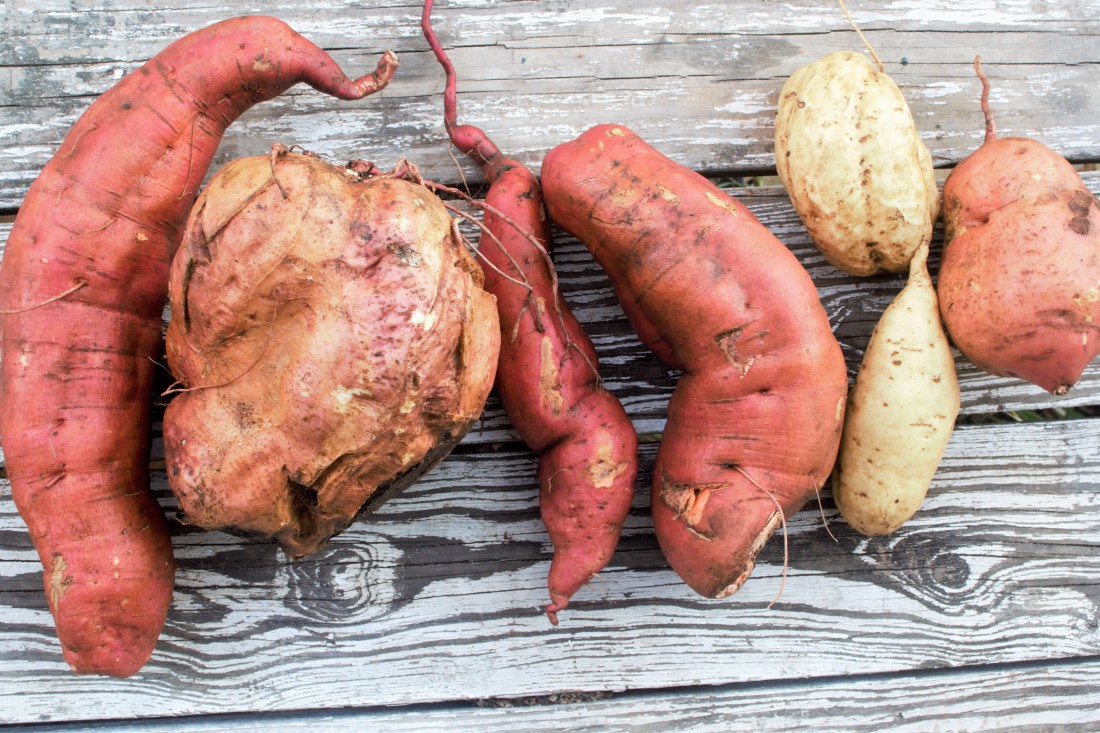I wonder how many of us grew up thinking sweet potatoes could only be served mixed with loads of brown sugar or dripping with toasted marshmallows. I personally did not wake from this sweet potato sugar coma until age 21, when a companion convinced me to try them roasted in their skins and adorned with nothing but butter. I fell in love with both the companion and the orange-fleshed tuber.
Fortunately for me, this humble root grows well in North Carolina, which produces more sweet potatoes than any other state in the U.S., according to the U.S. Department of Agriculture. “Sweet potatoes definitely grow well here in the mountains,” says Joe Evans, owner of Paper Crane Farm in Marshall. “I’d say our main challenge compared to the Piedmont is the cold. Sweet potatoes are a long-season crop that takes anywhere from 90-120 days to reach maturity. Our growing season is shorter here than in other parts of the state.”
Sweet potatoes don’t grow from seeds. They are one of those fascinating regenerative vegetables — plant a sweet potato, and it will grow baby sweet potatoes. Onions, ginger, turmeric, cassava and so-called “Irish” potatoes all fall into this unusual category.
In order to get a jump on the long growing season, most farmers plant slips — leafy sprouts grown out of a mature potato. They purchase the slips or grow them in a greenhouse until there is no danger of frost in the spring, then plant them in outdoor fields.
Young plants need lots of water, but once those slips take hold, miraculous things happen. Vigorous vines take over entire fields, or in my case, entire front yards. All summer long, as people walk past our house, they ask what vine is taking over the sidewalk. When savvy gardeners walk by they ask what varieties of sweet potatoes we grow.
Those leafy vines are great conversation starters and good ground cover, and the leaves themselves are incredibly delicious. I like to season them with smoked paprika, dry them in the oven and eat them like crunchy kale chips.
Chrisan Klak, co-owner of Blue Meadow Farms in Hendersonville, grew up eating taro leaves, and apparently sweet potato leaves are a good stand-in. “I’m Filipino, and we use them in Filipino culture and Asian culture,” she says. “Usually, a lot of the recipes that I follow for sweet potato greens are using taro leaves, but they have a similar texture and flavor, so I just use them in lieu of taro leaves.”
We don’t grow taro leaves in these parts, but Katherine Wilson of Katherine Wilson Nutrition Consulting explains, “Sweet potato greens can be cooked in the same way as spinach, chard and other leafy greens, and they may contain more nutrients than spinach.”
In the fall, leaf-covered vines get cut all the way back, and roots should be harvested before the first frost. Annie Louise Perkinson, co-owner of Flying Cloud Farm in Fairview, says, “Frost can ruin them, but also we don’t want them to get too big because people don’t want to buy a 6-pound sweet potato.”
I can speak from experience when I say cooking a 6-pound sweet potato takes some time. I almost always end up with something roughly the size and shape of a football when I harvest. After showing it off for several days, I light up the wood-fired oven, have a pizza party, and as the oven cools down overnight, the enormous sweet potato football bakes. In the morning, warm tender sweet flesh is ready to eat with butter or sorghum whipped cream for breakfast.
Perkinson agrees with me that roasting is one of the best ways to cook these sweet miracles. “I love leftovers because you can do anything with them — put them in soups, stews, quesadillas or pie,” she says.
Their versatility may be obvious, but when those marshmallow-topped, brown sugar-baked casseroles come out of the oven, we rarely think about nutrition. “Actually, sweet potatoes are packed with nutrients,” Wilson says. “They help boost immune function, eye health, cell growth and blood sugar regulation, and are a great addition to an anti-inflammatory diet.” She contends they are best without added sugar.
As if versatility and nutrient density were not enough, the variations in color, shape and size are almost endless. This year I grew round, yellow-fleshed Painters; orange, oblong Beauregards; and lanky, white Nancy Halls. Cut up and roasted together, they hardly look like the same vegetable.
The sweet potato edition of Crop Stories, a zine edited by André Joseph Gallant, describes purple-fleshed Okinawan, dark-red Georgia Jets and bright, gold-skinned Vardaman varieties. This informative journal offers planting, growing and management information as well as essays devoted to conditions for immigrant laborers working in sweet potato fields, stories of passionate farmers and intriguing recipes like one for a sweet potato adult milkshake.
I may make adult milkshakes my next holiday tradition. They should work well alongside my other traditions: whiskey-braised sweet potatoes and chocolate ginger sweet potato pie. Try one or all of them for your next festive feast.
Cathy Cleary is the former co-owner of West End Bakery and Café, a cookbook author and co-founder of FEAST, a nonprofit dedicated to cooking and gardening education. Her new book, The Southern Harvest Cookbook: Recipes Celebrating Four Seasons, debuts in January.



Before you comment
The comments section is here to provide a platform for civil dialogue on the issues we face together as a local community. Xpress is committed to offering this platform for all voices, but when the tone of the discussion gets nasty or strays off topic, we believe many people choose not to participate. Xpress editors are determined to moderate comments to ensure a constructive interchange is maintained. All comments judged not to be in keeping with the spirit of civil discourse will be removed and repeat violators will be banned. See here for our terms of service. Thank you for being part of this effort to promote respectful discussion.